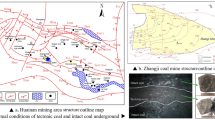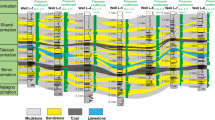In this paper, we propose a method for multi-vertical well synchronous hydraulic fracturing and compare with synchronous fracturing technologies used in shale. Based on theoretical analysis and triaxial fracturing experiments, we have shown that “face interference” in multi-vertical well synchronous fracturing helps to connect the cleats and generate complex fracture networks. The developed three-step method for designing synchronous fracturing technology was tested under field conditions. The results showed that application of synchronous fracturing decreases the gas breakthrough time in the wells and increases DCBM (deep coalbed methane) production. Furthermore, stress interference generated by synchronous fracturing has a positive impact on the production rate of wells adjacent to the experimental area.







Similar content being viewed by others
References
S. Li, D. Tang, Z. Pan et al., “Geological conditions of deep coalbed methane in the eastern margin of the Ordos Basin, China: Implications for coalbed methane development,” Journal of Natural Gas Science & Engineering, 53 (2018).
Y. Lu, Z. Yang, X. Li et al., “Problems and methods for optimization of hydraulic fracturing of deep coal beds in China,” Chemistry & Technology of Fuels & Oils, 51, No. 1, 41-48 (2015).
J. Zou, W. Chen, J. Yuan et al., “3-D numerical simulation of hydraulic fracturing in a CBM reservoir,” Journal of Natural Gas Science & Engineering, 37 (2016).
Q. Feng, J. Liu, Z. Huang et al., “Study on the optimization of fracturing parameters and interpretation of CBM fractured wells, ”Journal ofNatural Gas Geoscience (2018).
Y. Geng, D. Tang, H. Xu et al., “Experimental study on permeability stress sensitivity of reconstituted granular coal with different lithotypes,”Fuel, 202, 12-22 (2017).
M. S. A. Perera, P. G. Ranjith, D. R. Viete et al., “Parameters influencing the flow performance of natural cleat systems in deep coal seams experiencing carbon dioxide injection and sequestration,”, International Journal of Coal Geology, 104, No. 1, 96-106 (2012).
J. X. Han, Z. Z. Yang, H. L. Wang et al., “Leak-off model of fracturing fluid in coal seam,” Journal of China Coal Society, 39(S2), 441-446 (2014).
Y. Hu, Z. Li, J. Zhao et al., “Prediction and analysis of the stimulated reservoir volume for shale gas reservoirs based on rock failure mechanism,” Environmental Earth Sciences, 76, No. 15, 546 (2017).
X. Weng, O. Kresse, C. E. Cohen et al., “Modeling of hydraulic fracture network propagation in a naturally fractured formation,” SPE Production & Operations, 26, No. 4, 368-380 (2011).
W. Gary, G. W. Schein, and S. Weiss, “Simultaneous fracturing takes off: Enormous multiwell fracs maximize exposure to shale reservoirs, achieving more production sooner,” E & P, 81, No. 3, 55-58 (2008).
G. A. Waters, B. K. Dean, R. C. Downie, K. J. Kerrihard, L. Austbo, and B. McPl3herson, “Simultaneous hydraulic fracturing of adjacent horizontal wells in the Woodford shale,” SPE Hydraulic Fracturing Technology Conference, Woodlands, January 19-21, 2009.
J. Yao, Q. D. Zeng, Z. Q. Huang et al., “Numerical modeling of simultaneous hydraulic fracturing in the mode of multi-well pads,” Science China Technological Sciences, 60, No. 2, 232-242 (2017).
B. Sobhaniaragh, W. J. Mansur, and F. C. Peters, “The role of stress interference in hydraulic fracturing of horizontal wells,” International Journal of Rock Mechanics & Mining Sciences, 106, 153-1 (2018).
X. G. Li, L. P. Yi, and Z. Z. Yang, “Numerical model and investigation of simultaneous multiple fracture propagation within a stage in horizontal well,” Environmental Earth Sciences, 76, No. 7, 273 (2017).
D. Gao, Y. Liu, Z. Guo et al., “A study on optimization of CBM water drainage by well-test deconvolution in the early development stage,” Water, 10, No. 7, 929.64 (2018).
T. Fan, G. Zhang, and J. Cui, “The impact of cleats on hydraulic fracture initiation and propagation in coal seams,” Petroleum Science, 11, No. 4, 532-539 (2014).
W. Chen, H. Konietzky, C. Liu et al., “Hydraulic fracturing simulation for heterogeneous granite by discrete element method,” Computers & Geotechnics, 95, 1-15 (2018).
G. Rodriguez-Pradilla, “Microseismic monitoring of a hydraulic-fracturing operation in a CBM reservoir: Case study in the Cerrejon Formation, Cesar-Rancheria Basin, Colombia,” Geophysics: The Leading Edge of Exploration, 34, No. 8, 896-902 (2015).
This research was financially supported by the National Foundation for Major Projects in Science and Technology of China (2011ZX05042-002-001) and the Qihang Foundation of Southwest Petroleum University (No. 431).
Author information
Authors and Affiliations
Corresponding author
Additional information
Translated from Khimiya i Tekhnologiya Topliv i Masel, No. 3, pp. 57 — 63, May — June, 2019.
Rights and permissions
About this article
Cite this article
Yang, Z., He, R., Li, X. et al. Application of Multi-Vertical Well Synchronous Hydraulic Fracturing Technology for Deep Coalbed Methane (DCBM) Production. Chem Technol Fuels Oils 55, 299–309 (2019). https://doi.org/10.1007/s10553-019-01033-5
Published:
Issue Date:
DOI: https://doi.org/10.1007/s10553-019-01033-5




